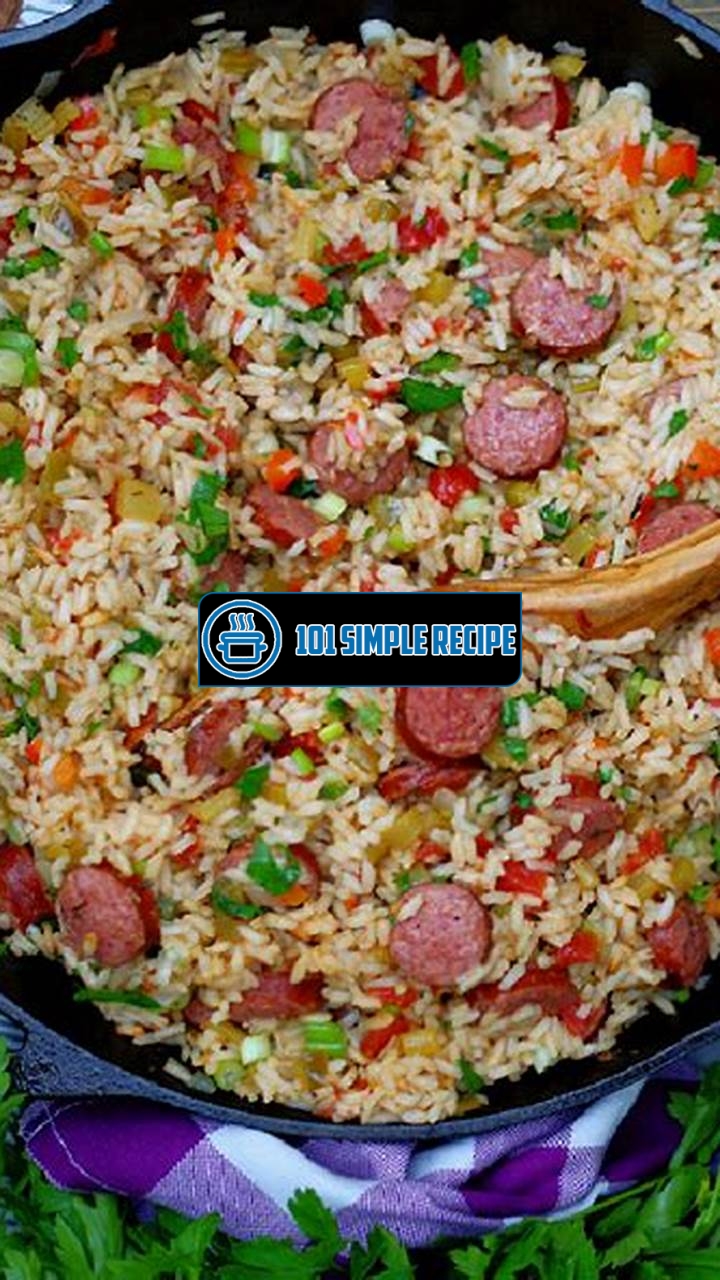Get ready to tantalize your taste buds with this mouthwatering recipe for delicious jambalaya with sausage, perfect for an authentic Cajun feast. ️ Whether you’re a fan of Cajun cuisine or looking to try something new, this flavorful dish is sure to impress. Jambalaya is a traditional Creole dish originating from Louisiana, known for its bold and spicy flavors. With a combination of succulent sausage, aromatic vegetables, and a medley of spices, this recipe will transport you straight to the heart of Cajun country. So put on your apron and get ready to embark on a culinary adventure that will leave you craving for more.

The Origin of Jambalaya
Discover the fascinating history behind jambalaya and its cultural significance in Louisiana.
The French and Spanish Influence
Jambalaya, a beloved Cajun dish known for its flavorful blend of rice, meat, and vegetables, has a rich history that can be traced back to the diverse culinary traditions of Louisiana. The origins of jambalaya can be attributed to the melding of French and Spanish influences in the region.
In the early 18th century, Louisiana was a melting pot of cultures, with French and Spanish settlers creating a unique blend of flavors in their cuisine. The French brought with them the technique of making “jambon à la yaya,” a rice dish cooked with ham. They adapted this dish to the local ingredients and the Creole lifestyle, resulting in the birth of jambalaya.
The Spanish, on the other hand, introduced the concept of sofrito to the region, a tomato-based sauce often used as a base in Spanish cooking. This influenced the flavor profile of jambalaya, adding a savory, aromatic component that sets it apart from other rice dishes.
- French and Spanish settlers melded their culinary traditions in Louisiana.
- Jambalaya is a result of this cultural fusion.
- The French brought the ham-based rice dish, while the Spanish introduced sofrito.
Jambalaya represents a delicious blend of French and Spanish influences.
As the recipe for jambalaya evolved over time, it incorporated ingredients and techniques from other cultures as well, highlighting the diverse heritage of the region.
The Evolution of Jambalaya
Jambalaya, much like the cultures that influenced it, has undergone several transformations throughout its history. The dish’s evolution can be attributed to the availability of ingredients and the creativity of the cooks who prepared it.
In the early days, jambalaya was primarily made with ham or other preserved meats, which were readily available in the region. However, as the availability of ingredients changed, cooks began incorporating different meats, such as poultry, sausage, and seafood, into the dish. This allowed for variations in flavor and texture.
Furthermore, jambalaya’s transition from a one-pot rice dish to a meal that can be served alongside other dishes or as a standalone main course showcases its adaptability. Chefs started experimenting with different seasonings, herbs, and spices to create unique flavor profiles, making each rendition of jambalaya distinct.
- Jambalaya has evolved over time to incorporate a variety of ingredients.
- Initially, it was made with ham or preserved meats.
- As availability changed, poultry, sausage, and seafood were added.
- Seasonings, herbs, and spices were introduced to create diverse flavor profiles.
Jambalaya has adapted to changing times, offering endless possibilities for culinary creativity.
Today, jambalaya is celebrated as a soul-satisfying dish that represents the cultural diversity and gastronomic heritage of Louisiana.
Jambalaya Variations Across Louisiana
While jambalaya is deeply rooted in Cajun and Creole cuisine, it’s important to note that different regions within Louisiana have their own unique variations of the dish.
In New Orleans, for example, jambalaya tends to be tomato-based and includes a wide variety of ingredients such as shrimp, chicken, and sausage. The addition of Cajun spices gives it a bold and spicy flavor profile.
On the other hand, in the southwestern part of the state, jambalaya is more influenced by Spanish flavors, with the addition of smoked chorizo and the use of saffron to achieve a vibrant, yellow color.
Each region puts its own spin on jambalaya, incorporating local ingredients and culinary traditions to create a truly authentic and flavorful rendition of the dish.
- Each region in Louisiana has its own variation of jambalaya.
- New Orleans jambalaya is tomato-based and includes shrimp, chicken, and sausage.
- Southwestern Louisiana jambalaya is influenced by Spanish flavors and uses smoked chorizo and saffron.
️ Jambalaya variations showcase the diverse culinary landscape of Louisiana.
Whether you’re enjoying a classic Cajun jambalaya or savoring a unique regional variation, this iconic dish continues to be a beloved symbol of Louisiana’s rich cultural heritage.
Key Ingredients for Jambalaya
When it comes to creating the perfect jambalaya, there are a few key ingredients that are essential in achieving its unique flavors and textures. From the holy trinity of onions, celery, and bell peppers to the spices and seasonings that bring the dish to life, each component plays a crucial role in making a delicious jambalaya recipe with sausage. Let’s dive into the details and explore these ingredients further.
The Holy Trinity: Onions, Celery, and Bell Peppers
The holy trinity of onions, celery, and bell peppers forms the base of many Cajun and Creole dishes, and jambalaya is no exception. These aromatic vegetables provide a robust foundation of flavors that infuse the dish with a savory essence. The onions add a sweet undertone, the celery adds a subtle crunch, and the bell peppers contribute a slight hint of bitterness. Together, they create a harmonious symphony of tastes that define authentic Cajun cuisine.
In Cajun cooking, the holy trinity is often sautéed in oil or butter until they soften and release their natural flavors. This process, known as “sweating,” allows the vegetables to caramelize slightly, enhancing their sweetness and adding depth to the dish. The holy trinity serves as the building block for the jambalaya, providing a strong base for the other ingredients to shine.
Spices and Seasonings
No jambalaya recipe with sausage would be complete without the perfect balance of spices and seasonings. The combination of flavors is what sets jambalaya apart and gives it its distinctive taste. Traditional Cajun seasonings, such as paprika, cayenne pepper, and thyme, add a bold and spicy kick to the dish. These aromatic spices infuse the jambalaya with a depth of flavor that tantalizes the taste buds.
Additionally, the use of garlic, bay leaves, and Worcestershire sauce further enhances the overall taste profile of the jambalaya. The garlic adds a pungent and slightly sweet note, while the bay leaves bring a subtle earthiness. Worcestershire sauce, with its tangy and savory characteristics, complements the other ingredients and adds complexity to the dish.
The Role of Sausage in Jambalaya
Now, let’s talk about the star of the show – sausage. In a jambalaya recipe with sausage, this ingredient plays a vital role in imparting a rich and smoky flavor to the dish. The sausage, typically Andouille sausage, is a spicy pork sausage heavily seasoned with a blend of spices like paprika, garlic, and cayenne pepper.
When the sausage is cooked, it releases its flavorful juices, which further enhance the taste profile of the jambalaya. The smokiness from the sausage infuses the dish, creating a depth of flavor that combines harmoniously with the other ingredients. The choice of sausage can greatly influence the overall taste of the jambalaya, so it’s important to select high-quality sausages to achieve the desired result.
In conclusion, the key ingredients in a jambalaya recipe with sausage are the holy trinity of onions, celery, and bell peppers, a variety of spices and seasonings, and the flavorful and smoky sausage. By harmonizing these essential components, you can create an authentic Cajun feast that will transport your taste buds to the vibrant streets of Louisiana. So gather your ingredients, fire up the stove, and get ready to savor the flavors of jambalaya!
Choosing the Right Sausage
When it comes to preparing a delicious jambalaya, the right choice of sausage can make all the difference. The flavors and textures of the sausage can greatly enhance the overall taste of the dish. In this article, we will explore different types of sausages and help you pick the perfect one to create an authentic Cajun feast. Let’s dive in!
Andouille: The Classic Choice
If you’re looking for the ultimate traditional flavor in your jambalaya, Andouille sausage is the way to go. Originating from Louisiana, this pork sausage is made with a blend of meat, spices, and smoked flavors that add depth and richness to the dish. Its coarse texture and smoky, peppery taste are what make it a classic choice for jambalaya.
Andouille sausage is usually made with pork butt, seasoned with garlic, onion, paprika, cayenne pepper, and other spices. The sausage is then smoked over pecan wood, which further enhances its distinctive taste. Its slightly spicy flavor profile complements the bold and robust flavors of jambalaya perfectly, making it a popular choice among Cajun cuisine enthusiasts.
Smoked Sausage: A Flavorful Alternative
If you’re looking to switch things up or prefer a milder flavor, consider using smoked sausage in your jambalaya. This sausage is known for its rich, smoky taste and tender texture. It is made by smoking cured pork, beef, or a combination of both, resulting in a savory and flavorful addition to your jambalaya.
The smokiness of this sausage adds depth to the overall dish, while its tender and juicy texture provides a delightful contrast to the other ingredients. It pairs well with the spices and seasonings commonly used in jambalaya, creating a harmonious blend of flavors.
Other Sausage Varieties to Consider
While Andouille and smoked sausage are the top choices for jambalaya, there are other varieties that can add a unique touch to your dish. Here are a few to consider:
- Chorizo: A Spanish sausage with a spicy kick, chorizo can add a burst of flavor to your jambalaya. Its distinctive taste and vibrant red color can elevate the visual and culinary experience.
- Kielbasa: Originating from Poland, kielbasa is a versatile sausage that can bring a slightly smoky and garlicky taste to your jambalaya.
- Italian Sausage: With its blend of herbs and spices, Italian sausage can lend a Mediterranean twist to your jambalaya. Choose sweet or spicy, depending on your preference.
Note: Don’t hesitate to experiment with different sausage varieties to find your personal favorite. Each type of sausage brings its own unique flavors and characteristics to the dish, allowing you to create a jambalaya that suits your taste perfectly.
Now that you’re familiar with different sausage options for your jambalaya, it’s time to put your culinary skills to the test. Whether you choose the classic Andouille sausage, opt for the smoky richness of smoked sausage, or explore other varieties, the right choice of sausage will undoubtedly take your jambalaya to new heights of flavor. Enjoy your authentic Cajun feast!
Prepping and Cooking the Jambalaya
To create an authentic Cajun feast right in the comfort of your own kitchen, you need to master the art of preparing and cooking a delicious jambalaya with sausage. This traditional Southern dish is packed with flavor and is sure to impress your taste buds. Let’s dive into the step-by-step process to ensure your jambalaya turns out perfectly every time.
Sautéing the Holy Trinity
The first step in creating a mouthwatering jambalaya is sautéing the holy trinity of Cajun cooking: onions, bell peppers, and celery. These aromatic vegetables serve as the flavor base for the dish and provide a delightful crunch. Start by heating a large pot or Dutch oven over medium heat and adding a generous amount of oil. Once the oil is hot, toss in the chopped onions, bell peppers, and celery, and sauté until they become fragrant and slightly softened. This process ensures that the flavors of the holy trinity meld together, creating a delicious foundation for your jambalaya.
Addition of Rice and Liquid
Now that your holy trinity is perfectly sautéed, it’s time to add the star of the show: the rice. Use long-grain rice, as it holds its shape well and absorbs the flavors of the dish beautifully. Pour the rice into the pot and stir it around, allowing each grain to be coated with the aromatic mixture.
Next, it’s time to add the liquid. Traditional jambalaya recipes call for a combination of chicken broth and canned diced tomatoes. This adds depth of flavor and a slight tanginess to the dish. Slowly pour in the liquid, ensuring that it covers the rice completely. You want the rice to absorb the liquid as it cooks, creating a tender and flavorful bite.
Simmering and Stirring Techniques
Once the rice and liquid are added, it’s time to bring your jambalaya to a simmer. Reduce the heat to low, cover the pot, and let it simmer for about 20 to 25 minutes, or until the rice is fully cooked and tender. During this time, resist the temptation to lift the lid and peek at your creation. Keeping the lid on ensures that the steam and flavors are trapped inside the pot, resulting in a perfectly cooked jambalaya.
While your jambalaya is simmering, it’s important to give it a good stir every now and then. This ensures that the rice cooks evenly and prevents it from sticking to the bottom of the pot. Use a wooden spoon or spatula to gently stir the jambalaya, making sure to scrape the bottom to release any flavorful bits that may have caramelized.
In conclusion, mastering the art of preparing and cooking a delicious jambalaya with sausage is a skill worth acquiring. By sautéing the holy trinity, adding the rice and liquid, and employing simmering and stirring techniques, you can create an authentic Cajun feast that will transport your taste buds straight to the heart of Louisiana.
Tips for Perfecting Your Jambalaya
Discover valuable tips and tricks to take your jambalaya with sausage to the next level.
Letting Flavors Marinate Overnight
To achieve the most flavorful jambalaya, it’s crucial to let the ingredients marinate overnight. This step allows the spices and seasonings to penetrate the meat and vegetables, resulting in a more intense and authentic taste. By giving the flavors time to meld together, you’ll ensure a delicious and satisfying dish.
Tip: Before marinating, make sure to mix all the ingredients thoroughly to evenly distribute the spices and seasonings.
Choosing the Right Rice
The choice of rice for your jambalaya can greatly affect its texture and overall taste. It’s important to select a rice variety that can absorb the flavors of the dish without becoming mushy. The two popular options for jambalaya are long grain rice and converted rice.
Long Grain Rice: This variety tends to stay separated and fluffy when cooked, making it an excellent choice for jambalaya. Its firm texture allows it to absorb the flavors of the sausage and other ingredients while maintaining its integrity.
⚖️ Converted Rice: Converted rice is parboiled before packaging, making it less prone to overcooking and sticking together. This type of rice is a great option if you prefer a more tender and moist jambalaya.
Garnishing and Serving Suggestions
Enhancing the visual appeal of your jambalaya with sausage can be just as important as its taste. Here are some garnishing and serving suggestions that will elevate your dish to a new level:
️ Spicy Kick: If you enjoy a spicier jambalaya, sprinkle some red pepper flakes on top before serving. This will add an extra burst of heat to every bite.
Fresh Herbs: Finely chopped parsley or green onions make excellent garnishes for jambalaya. They not only add a pop of color but also contribute a refreshing flavor.
Citrus Zest: Before serving, grate some lemon or lime zest over the jambalaya. The citrusy aroma will awaken your taste buds and add a bright note to the dish.
Crusty Bread: Serve your jambalaya with a side of crusty French bread. The combination of flavors and textures will make for a satisfying meal.
With these tips, you’re now equipped to create a mouthwatering jambalaya with sausage. Remember to marinate the flavors, choose the right rice, and garnish and serve your dish with flair. Enjoy your authentic Cajun feast!
Frequently Asked Questions
If you have any questions or concerns about the jambalaya recipe with sausage, we are here to help! Take a look at some of the most frequently asked questions below:
| No. | Questions | Answers |
|---|---|---|
| 1. | What is jambalaya? | Jambalaya is a flavorful dish that originated in Louisiana. It is typically made with a combination of meat, vegetables, and rice, seasoned with various spices. |
| 2. | Can I use different types of sausage? | Absolutely! Feel free to experiment with different types of sausage to find your favorite flavor combination. Andouille sausage is a popular choice for jambalaya, but you can use any sausage you prefer. |
| 3. | Can I make jambalaya in advance? | Yes, you can make jambalaya in advance and store it in the refrigerator. Just be sure to properly cool it down before storing and reheat thoroughly before serving. |
| 4. | Is jambalaya spicy? | Jambalaya can be as spicy as you want it to be. Adjust the amount of spices and seasonings to your preference. If you prefer a milder flavor, you can reduce the amount of spicy ingredients like cayenne pepper. |
| 5. | Can I add other ingredients to jambalaya? | Absolutely! Jambalaya is a versatile dish that can be customized to your liking. Feel free to add other ingredients such as shrimp, chicken, or vegetables to create your own unique version. |
| 6. | What should I serve with jambalaya? | Jambalaya is a filling and hearty dish on its own, but you can serve it with a side of cornbread, crusty French bread, or a fresh green salad to complete the meal. |
Thank You for Reading!
We hope you enjoyed learning about the delicious jambalaya recipe with sausage. Give it a try in your own kitchen and impress your family and friends with this flavorful Cajun dish. Remember to visit our website again for more mouthwatering recipes and culinary tips. Happy cooking! ️
Jump to Recipe
Jambalaya Recipe with Sausage

Learn how to make a delicious jambalaya recipe with sausage. This Cajun classic is packed with flavors and is perfect for a comforting dinner.
- 1 lb sausage (sliced)
- 1 onion (diced)
- 1 bell pepper (diced)
- 2 celery stalks (diced)
- 3 cloves garlic (minced)
- 1 can diced tomatoes
- 1 cup chicken broth
- 1 cup long-grain rice
- 2 tsp Cajun seasoning
- 1 tsp paprika
- 1/2 tsp thyme
- 1/2 tsp oregano
- 1/4 tsp cayenne pepper
- Salt and pepper to taste
- In a large skillet or Dutch oven, cook the sausage over medium heat until browned. Remove the sausage from the skillet and set aside.
- In the same skillet, add the onion, bell pepper, celery, and garlic. Cook until the vegetables are softened.
- Add the diced tomatoes, chicken broth, rice, Cajun seasoning, paprika, thyme, oregano, and cayenne pepper to the skillet. Stir well to combine.
- Bring the mixture to a boil, then reduce heat to low. Cover and simmer for 20-25 minutes, or until the rice is cooked and the liquids are absorbed.
- Stir in the cooked sausage and season with salt and pepper to taste. Cook for an additional 5 minutes to heat the sausage.
- Serve the jambalaya hot and enjoy!






